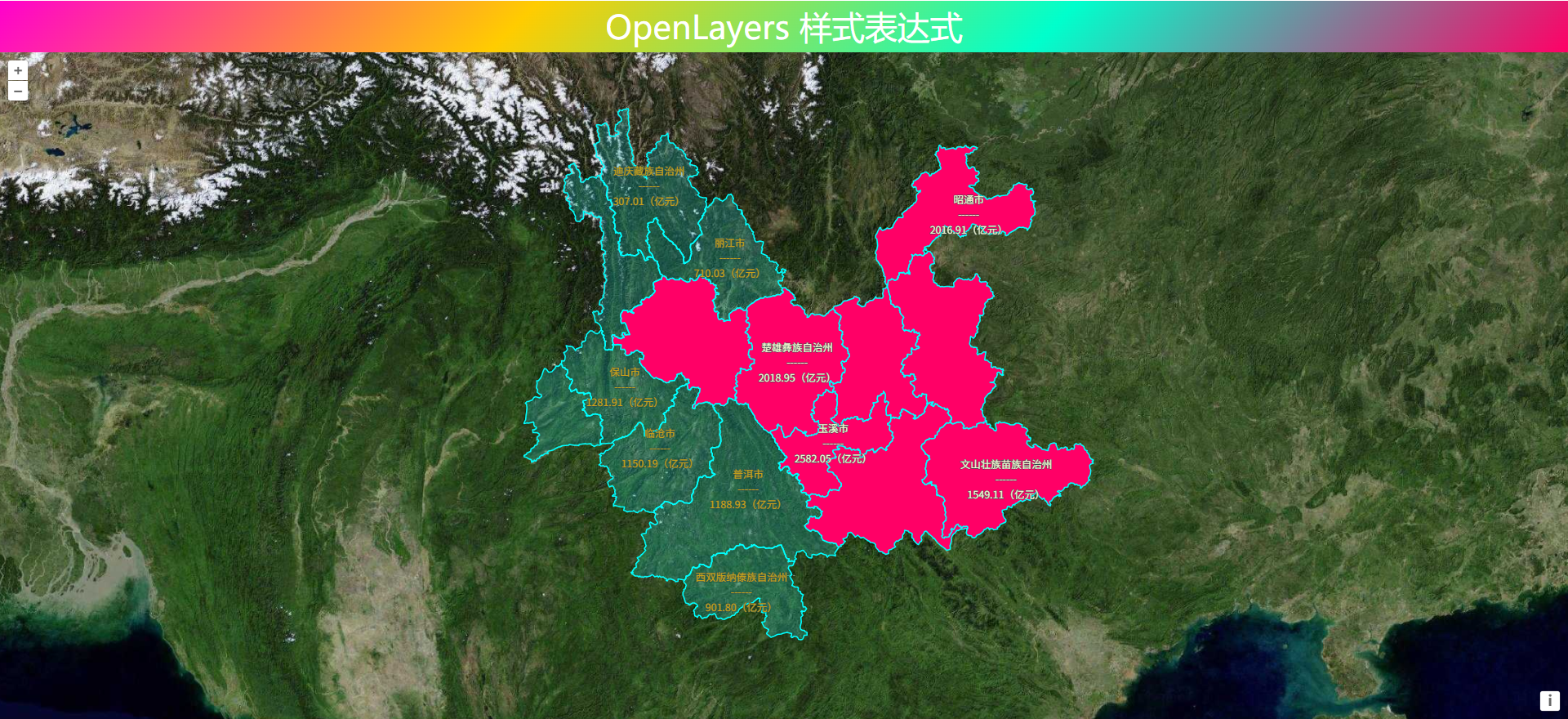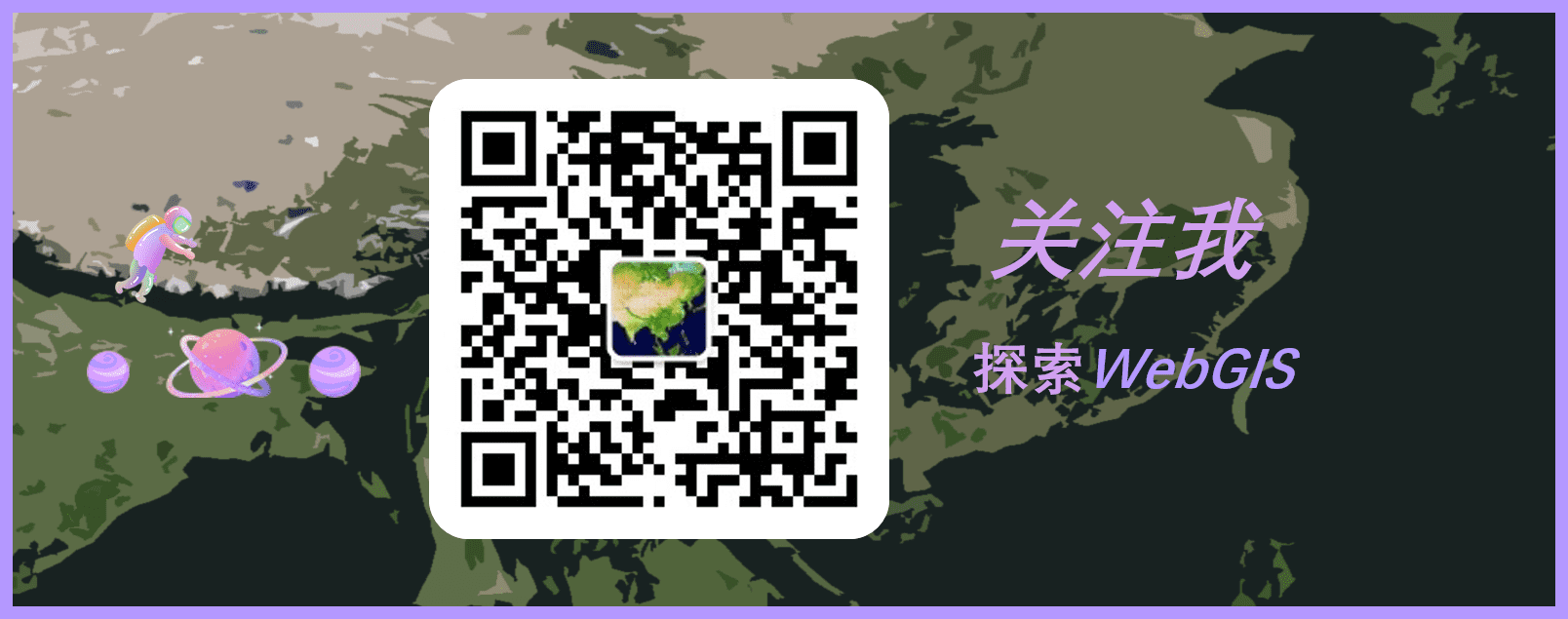^ 关注我,带你一起学GIS ^
注:当前使用的是 ol [9.2.4] 版本,天地图使用的key请到天地图官网申请,并替换为自己的key
 前言
前言
❝在现代地图应用中,时间信息的可视化是一个重要且有趣的功能。通过结合地理空间与时间数据,我们可以直观地展示全球不同地区的时间差异,例如时区分布、昼夜变化等。OpenLayers 作为一款强大的开源地图库,提供了灵活的 API 和丰富的功能,能够轻松实现世界时间的动态展示。本文将介绍如何利用 OpenLayers 实现世界时间的可视化,并通过示例展示如何根据时间偏移量动态调整地图元素的样式(如不透明度),从而为用户提供直观的时间分布信息。
在OpenLayers官方例子中,发现一个有趣的案例,可以通过时间偏移量进行图层样式调整。感觉比较有实践意义,推荐大家尝试以下。
详情可参考官网:https://openlayers.org/en/v9.2.4/examples/kml-timezones.html
1. 时间样式函数
该样式函数基于当地中午时间的偏移量设置多边形样式,根据时间大小计算要素的透明度。
/**
* @description:样式计算函数
* 基于当地中午时间的偏移量计算多边形的透明度。例如,如果所在时区当前时间为中午的话不透明为0.75;
* 而所在时区当前显示时间为午夜的话不透明度为0
* 需要注意的是,此计算未考虑夏令时,因此请不要将其用于规划假期。
*/
const styleFunction = function (feature) {
const tzOffset = feature.get("tz-offset")
const local = new Date()
local.setTime(
local.getTime() + (local.getTimezoneOffset() + (tzOffset || 0)) * 6000
)
// 从中午开始的偏移量
let delta = Math.abs(12 - (local.getHours() + local.getMinutes() / 60))
if (delta > 12) {
delta = 24 - delta
}
const opacity = 0.75 * (1 - delta / 12)
return new ol.style.Style({
fill: new ol.style.Fill({
color: [0xff, 0xff, 0x33, opacity],
}),
stroke: new ol.style.Stroke({
color: '#ffffff',
})
})
}
以上styleFunction变量为样式函数,具有一个feature参数。样式函数在OpenLayers开发中具有重要作用,通常用于设置文本标注样式,可根据业务需求进行字段展示,最后返回一个Style对象。样式函数中delta变量为时间偏移量,该值用于控制要素的不透明度。
2. 加载时区图层
使用矢量数据源和矢量图层加载时区数据。例子中该矢量数据格式为KML,所以使用ol.format.KML类进行加载。在KML对象中将extractStyles属性设置为false,即不从KML图层中提取样式,默认为true。
// 加载时区图层
const worldVector = new ol.layer.Vector({
source: new ol.source.Vector({
url: "../../data/kml/timezones.kml",
format: new ol.format.KML({
// 不提取KML样式
extractStyles: false
})
}),
style: styleFunction
})
3. 解析世界时间
在以下代码中使用正则表达式匹配字符串末尾的时间偏移量格式,并将其转换为以分钟为单位的值。
// 解析时间
function parseOffsetFromUTC(name) {
const match = name.match(/([+-]?)(d{2}):(d{2})$/)
if (!match) {
return null
}
const sign = match[1] === "-" ? -1 : 1
const hours = Number(match[2])
const minutes = Number(match[3])
// 将时间转换为分钟
return sign * (60 * hours * minutes)
}
name.match(/([+-]?)(\d{2}):(\d{2})$/)该正则表达式分解如下:
([+-]?):匹配一个可选的+或-符号,表示偏移方向。(d{2}):匹配两位数字,表示小时部分。::匹配冒号分隔符。(d{2}):匹配两位数字,表示分钟部分。`:确保匹配的是字符串的末尾。
4. 监听时区图层
监听featuresloadend数据源事件,当图层要素加载完成后,遍历所有要素,并赋予要素属性"tz-offset"
worldVector.getSource().on("featuresloadend", function (evt) {
evt.features.forEach(feature => {
const tzOffset = parseOffsetFromUTC(feature.get("name"))
// 设置"tz-offset"属性
feature.set("tz-offset", tzOffset, true)
})
})
map.addLayer(worldVector)
5. 显示图层信息
displayFeatureInfo函数用于显示要素信息。在该函数中,使用forEachFeatureAtPixel方法查找最近的地图要素,如果查询到了矢量要素则显示信息弹出框,否则隐藏。
let currentFeature
const displayFeatureInfo = function (pixel, target) {
const feature = target.closest('.ol-control')
? undefined
: map.forEachFeatureAtPixel(pixel, function (feature) {
return feature;
});
if (feature) {
info.style.left = pixel[0] + "px"
info.style.top = pixel[1] + "px"
if (feature !== currentFeature) {
tooltip.setContent({ '.tooltip-inner': feature.get('name') });
}
if (currentFeature) {
tooltip.update()
} else {
tooltip.show()
}
} else {
tooltip.hide()
}
currentFeature = feature
}
在以下代码中,通过监听地图事件显示和隐藏信息弹出框。
// 监听地图移动事件
map.on('pointermove', function (evt) {
if (evt.dragging) {
tooltip.hide();
currentFeature = undefined;
return;
}
const pixel = map.getEventPixel(evt.originalEvent);
displayFeatureInfo(pixel, evt.originalEvent.target);
});
// 监听地图点击事件
map.on("click", function (evt) {
displayFeatureInfo(evt.pixel, evt.originalEvent.target)
})
// 监听地图元素移除事件
map.getTargetElement().addEventListener("pointerleave", function (evt) {
tooltip.hide()
currentFeature = undefined
})
6. 完整代码
其中libs文件夹下的包需要更换为自己下载的本地包或者引用在线资源。
<!DOCTYPE html>
<html>
<head>
<meta http-equiv="Content-Type" content="text/html; charset=utf-8" />
<title>OpenLayers 显示世界时间</title>
<meta charset="utf-8" />
<link rel="stylesheet" href="../../libs/css/ol9.2.4.css">
<link rel="stylesheet" href="../../libs/css/bootstrap5.2.0.min.css">
<script src="../../libs/js/bootstrap5.2.0.bundle.min.js"></script>
<script src="../../js/config.js"></script>
<script src="../../libs/js/ol9.2.4.js"></script>
<style>
* {
padding: 0;
margin: 0;
font-size: 14px;
font-family: '微软雅黑';
}
html,
body {
width: 100%;
height: 100%;
}
#map {
position: absolute;
top: 50px;
bottom: 0;
width: 100%;
}
#top-content {
position: absolute;
width: 100%;
height: 50px;
line-height: 50px;
background: linear-gradient(135deg, #ff00cc, #ffcc00, #00ffcc, #ff0066);
color: #fff;
text-align: center;
font-size: 32px;
}
#top-content span {
font-size: 32px;
}
#info {
position: absolute;
height: 1px;
width: 1px;
z-index: 100;
}
</style>
</head>
<body>
<div id="top-content">
<span>OpenLayers 显示世界时间</span>
</div>
<div id="map" title="">
<div id="info"></div>
</div>
</body>
</html>
<script>
//==============================================================================//
//============================天地图服务参数简单介绍==============================//
//================================vec:矢量图层==================================//
//================================img:影像图层==================================//
//================================cva:注记图层==================================//
//======================其中:_c表示经纬度投影,_w表示球面墨卡托投影================//
//==============================================================================//
const TDTImgLayer = new ol.layer.Tile({
title: "天地图影像图层",
source: new ol.source.XYZ({
url: "http://t0.tianditu.com/DataServer?T=img_w&x={x}&y={y}&l={z}&tk=" + TDTTOKEN,
attibutions: "天地图影像描述",
crossOrigin: "anoymous",
wrapX: true
})
})
const TDTImgCvaLayer = new ol.layer.Tile({
title: "天地图影像注记图层",
source: new ol.source.XYZ({
url: "http://t0.tianditu.com/DataServer?T=cia_w&x={x}&y={y}&l={z}&tk=" + TDTTOKEN,
attibutions: "天地图注记描述",
crossOrigin: "anoymous",
wrapX: true
})
})
const map = new ol.Map({
target: "map",
loadTilesWhileInteracting: true,
view: new ol.View({
center: [102.845864, 25.421639],
zoom: 2,
worldsWrap: true,
minZoom: 1,
maxZoom: 20,
projection: "EPSG:4326",
}),
layers: [TDTImgLayer, TDTImgCvaLayer],
// 地图默认控件
controls: ol.control.defaults.defaults({
zoom: false,
attribution: false,
rotate: false
})
})
/**
* @description:样式计算函数
* 基于当地中午时间的偏移量计算多边形的透明度。例如,如果所在时区当前时间为中午的话不透明为0.75;
* 而所在时区当前显示时间为午夜的话不透明度为0
* 需要注意的是,此计算未考虑夏令时,因此请不要将其用于规划假期。
*/
const styleFunction = function (feature) {
const tzOffset = feature.get("tz-offset")
const local = new Date()
local.setTime(
local.getTime() + (local.getTimezoneOffset() + (tzOffset || 0)) * 6000
)
// 从中午开始的偏移量
let delta = Math.abs(12 - (local.getHours() + local.getMinutes() / 60))
if (delta > 12) {
delta = 24 - delta
}
const opacity = 0.75 * (1 - delta / 12)
return new ol.style.Style({
fill: new ol.style.Fill({
color: [0xff, 0xff, 0x33, opacity],
}),
stroke: new ol.style.Stroke({
color: '#ffffff',
})
})
}
// 加载时区图层
const worldVector = new ol.layer.Vector({
source: new ol.source.Vector({
url: "../../data/kml/timezones.kml",
format: new ol.format.KML({
extractStyles: false
})
}),
style: styleFunction
})
// 解析时间
function parseOffsetFromUTC(name) {
const match = name.match(/([+-]?)(\d{2}):(\d{2})$/)
if (!match) {
return null
}
const sign = match[1] === "-" ? -1 : 1
const hours = Number(match[2])
const minutes = Number(match[3])
// 将时间转换为分钟
return sign * (60 * hours * minutes)
}
worldVector.getSource().on("featuresloadend", function (evt) {
evt.features.forEach(feature => {
const tzOffset = parseOffsetFromUTC(feature.get("name"))
// 设置"tz-offset"属性
feature.set("tz-offset", tzOffset, true)
})
})
map.addLayer(worldVector)
const info = document.getElementById('info');
info.style.pointerEvents = 'none';
const tooltip = new bootstrap.Tooltip(info, {
animation: false,
customClass: 'pe-none',
offset: [0, 5],
title: '-',
trigger: 'manual',
});
let currentFeature
const displayFeatureInfo = function (pixel, target) {
const feature = target.closest('.ol-control')
? undefined
: map.forEachFeatureAtPixel(pixel, function (feature) {
return feature;
});
if (feature) {
info.style.left = pixel[0] + "px"
info.style.top = pixel[1] + "px"
if (feature !== currentFeature) {
tooltip.setContent({ '.tooltip-inner': feature.get('name') });
}
if (currentFeature) {
tooltip.update()
} else {
tooltip.show()
}
} else {
tooltip.hide()
}
currentFeature = feature
}
// 监听地图移动事件
map.on('pointermove', function (evt) {
if (evt.dragging) {
tooltip.hide();
currentFeature = undefined;
return;
}
const pixel = map.getEventPixel(evt.originalEvent);
displayFeatureInfo(pixel, evt.originalEvent.target);
});
// 监听地图点击事件
map.on("click", function (evt) {
displayFeatureInfo(evt.pixel, evt.originalEvent.target)
})
// 监听地图元素移除事件
map.getTargetElement().addEventListener("pointerleave", function (evt) {
tooltip.hide()
currentFeature = undefined
})
</script>
❝
OpenLayers示例数据下载,请在公众号后台回复:ol数据
全国信息化工程师-GIS 应用水平考试资料,请在公众号后台回复:GIS考试
❝
GIS之路公众号已经接入了智能助手,欢迎大家前来提问。
欢迎访问我的博客网站-长谈GIS:
http://shanhaitalk.com
都看到这了,不要忘记点赞、收藏+关注 哦!
本号不定时更新有关 GIS开发 相关内容,欢迎关注 


